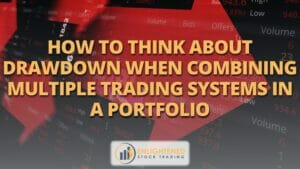If you have a strategy or system that you’ve backtested over a long period, look at how it performed over different periods. Let’s say you’ve had three weeks of drawdown, if you run a backtest over the last 10 to 20 years or how much data you’ve got, you can look at all of the three week periods and ask whether a three-week drawdown is common? Does that always happen or is that new? If it’s new, you have a problem if there’s never been a drawdown that long. However, chances are, it’s not new, and it’s very well within the bounds of what is normal and expected by the system.
In a drawdown, run the whole backtest and look at the current performance, is that normal or should you stop the system? You’ve got all of this performance to check if this is normal. Can you find this behaviour in this backtest? So if your current drawdown is 30% and the maximum previous drawdown was 10%, you have a problem. If your current drawdown is 25% and your maximum previous drawdown was 25% or 24% or 26%, you probably don’t have a problem.
However, once it exceeds what is normal from the backtest perspective, you need to look at the system. Look at all performance measures, understand what’s shifting and changing, and evaluate whether something is deteriorating. You might find that sometimes an indicator becomes less effective because too many people are using it, which is very common. This happened to a short-term RSI in the US stock market back around 2009-2010, wherein it became much less effective than it had been previously.
When you dig into it and find that the percentage of trades was falling, your system’s in trouble. Therefore, you should dig in a little further, don’t just look at the headline performance. If your drawdown is bigger than expected, you have a problem and should at least pause or suspend the system then investigate. However, when you look at all of the other performance measures, you’ll see whether things are degrading systematically or not.









Share This
Share this post with your friends!